Maryland boasts a diverse range of bird species, from vibrant songbirds to impressive raptors. Knowing the common birds in the region can greatly enhance any outdoor experience. This guide presents 42 frequently spotted birds in Maryland, complete with photos and identification details.
Each bird includes clear descriptions of its appearance, behavior, habitat, and typical locations throughout the state. From the bright Northern Cardinal to the intelligent Blue Jay, this guide helps you recognize these birds in forests, parks, and residential areas.
Learning to identify Maryland’s common birds deepens appreciation for local wildlife and encourages conservation awareness. This comprehensive resource equips you to enjoy and protect the rich birdlife found across Maryland.
Species of Birds Found in Maryland
Northern Cardinal (Cardinalis cardinalis)
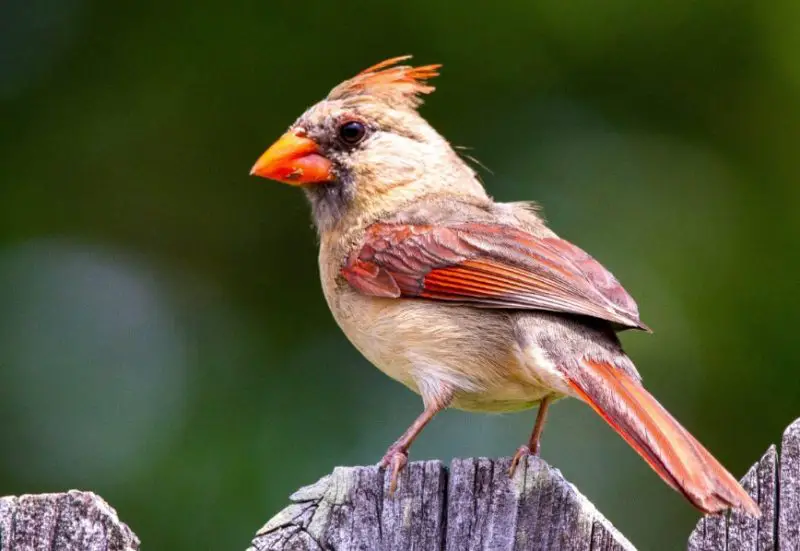
The Northern Cardinal is one of the most recognizable and beloved birds in Maryland, easily identified by its bright red plumage in males and warm brownish tones in females, both with a distinct crest and a bold black mask around the face. These medium-sized songbirds measure around 8.3–9.1 inches in length and have a wingspan of about 9.8–12.2 inches. Their stout, orange-red beaks are perfectly shaped for cracking seeds, one of their main food sources.
Northern Cardinals are year-round residents in Maryland, commonly found in woodlands, gardens, shrublands, and suburban backyards. They are known for their clear, whistling songs and sharp “chip” calls, often heard early in the morning. Males sing to establish territory and attract mates, and both sexes may engage in feeding each other during courtship displays.
A fun fact about the Northern Cardinal is that they were once prized as cage birds due to their beauty and song, but capturing them is now illegal under the Migratory Bird Treaty Act. They do not migrate, so they bring a welcome splash of color to winter landscapes in Maryland. Their adaptability to human-altered environments has made them one of the most common backyard birds across the state.
American Robin (Turdus migratorius)

The American Robin is a familiar sight in Maryland, especially in the spring and summer months. It’s a medium-sized thrush, about 9–11 inches in length, with a gray-brown back, warm orange-red breast, and a white patch under the tail. Robins have a rounded body, upright posture, and a yellow bill with a slightly darker tip. Their appearance and musical song make them a classic symbol of spring.
Robins are highly adaptable and can be found across Maryland in a wide range of habitats, including forests, lawns, parks, and farmlands. They feed primarily on earthworms, insects, and berries, often seen hopping across lawns in search of food. Although they are migratory, many overwinter in Maryland, especially if food sources like fruiting trees are available.
A fun fact about the American Robin is that despite being called a robin, it’s not related to the European Robin. It was named by early settlers who were reminded of the red-breasted birds back home. In Maryland, robins often begin nesting early, sometimes while snow is still on the ground, and they can raise two to three broods in a single breeding season.
Blue Jay (Cyanocitta cristata)
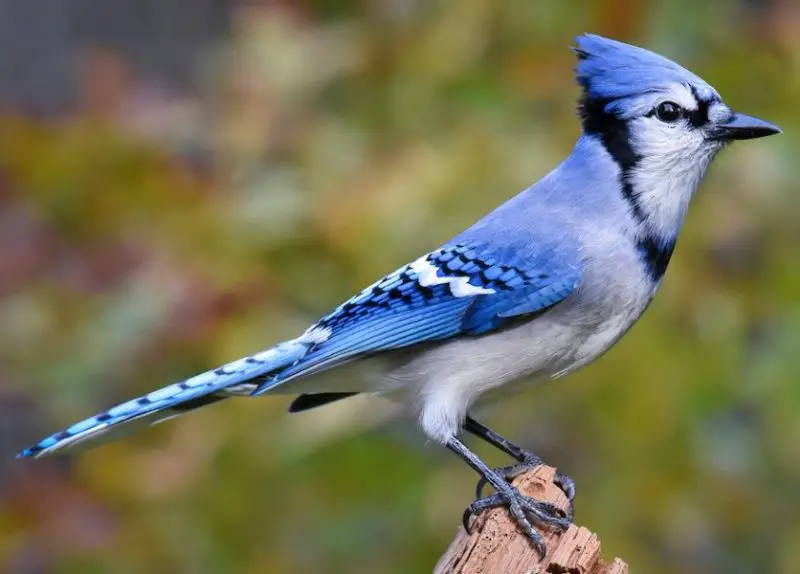
The Blue Jay is a striking and intelligent bird that is easy to identify in Maryland thanks to its bright blue crest, black necklace, and white underparts. Measuring around 9–12 inches in length, Blue Jays have broad wings and a long, expressive tail with intricate black, white, and blue patterns. They are members of the crow family, known for their bold behavior and vocalizations.
In Maryland, Blue Jays are common in woodlands, parks, and residential areas, especially where oak trees are present, as acorns are a favored food. They are omnivorous and opportunistic feeders, eating everything from seeds and nuts to insects, fruits, and occasionally small vertebrates. They are known to mimic the calls of hawks, possibly to scare off other birds from food sources.
A fun fact about Blue Jays is that they are excellent at caching food for later use. They can store hundreds of acorns in various locations, helping with seed dispersal. Their complex social behavior and sharp memory make them one of the most fascinating backyard birds in Maryland.
Carolina Chickadee (Poecile carolinensis)
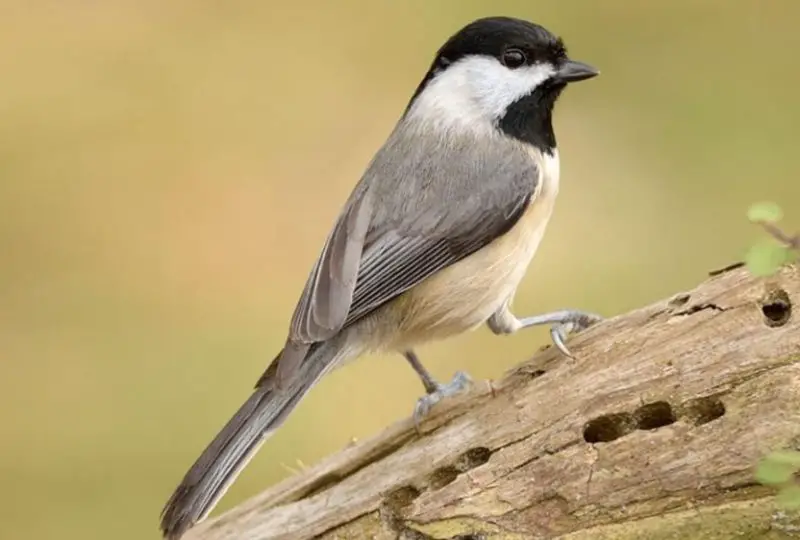
The Carolina Chickadee is a tiny, curious bird with a black cap and bib, white cheeks, grayish wings and back, and a buffy underside. It measures about 4.7–5.1 inches in length and has a short neck and large head, giving it a distinctive, rounded appearance. These birds are known for their quick movements and distinctive “chick-a-dee-dee-dee” call.
Carolina Chickadees are non-migratory and found throughout Maryland’s forests, woodlots, and suburban neighborhoods, often seen at bird feeders. They are insectivorous during the summer, feeding on caterpillars, beetles, and spiders, and shift to seeds and berries in the winter. They are cavity-nesting birds and often use old woodpecker holes or nest boxes.
A fun fact about Carolina Chickadees is that they have exceptional memory and spatial awareness, enabling them to relocate hundreds of food caches hidden in bark and foliage. Despite their small size, they are bold and inquisitive, often being one of the first birds to explore new feeders or habitats in Maryland yards.
Tufted Titmouse (Baeolophus bicolor)
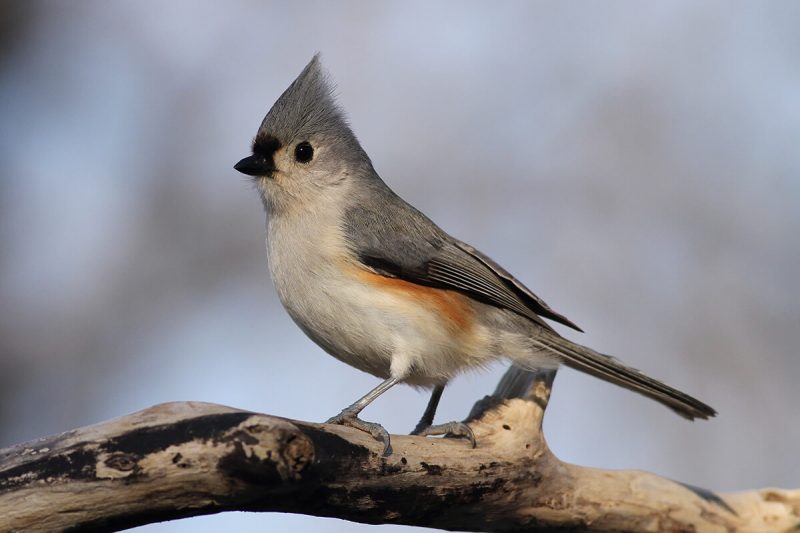
The Tufted Titmouse is a small songbird with a distinctive gray crest, large black eyes, soft gray upperparts, and white underparts with a hint of peach along the sides. It measures around 5.5–6.3 inches long and has a short, stout bill. Its expressive face and gentle appearance make it a favorite among birdwatchers.
In Maryland, the Tufted Titmouse is a year-round resident, commonly found in deciduous woodlands, wooded suburbs, and backyard feeders. They are social birds, often seen traveling with mixed-species flocks including chickadees, nuthatches, and woodpeckers. Their diet includes insects, seeds, and berries, and they often visit feeders for sunflower seeds and suet.
A fun fact about Tufted Titmice is that they are known to line their nests with hair plucked from live animals, including pets like dogs and squirrels. This behavior, though surprising, helps insulate their nests. Their clear, whistled “peter-peter-peter” song is a familiar sound in many Maryland forests and gardens.
Downy Woodpecker (Dryobates pubescens)

The Downy Woodpecker is the smallest woodpecker in North America, measuring just 5.5–6.7 inches in length with a wingspan of 9.8–11.8 inches. It features black-and-white plumage with a white belly, black wings spotted with white, and a broad white stripe down its back. Males have a small red patch on the back of the head, while females lack this marking. Their short, chisel-like bill is proportionately smaller than other woodpeckers.
This species is a year-round resident throughout Maryland and is commonly seen in deciduous forests, orchards, parks, and backyards. It feeds on insects, especially beetle larvae and ants, but also consumes seeds and berries. Downy Woodpeckers often visit suet feeders and are known for their sharp “pik” calls and quick drumming on trees and posts.
A fun fact about the Downy Woodpecker is that it uses its stiff tail feathers as a prop while climbing tree trunks. Despite its small size, it can survive harsh winters by roosting in tree cavities. It also frequently joins mixed-species foraging flocks, often seen alongside chickadees and titmice in Maryland woodlands.
Red-bellied Woodpecker (Melanerpes carolinus)
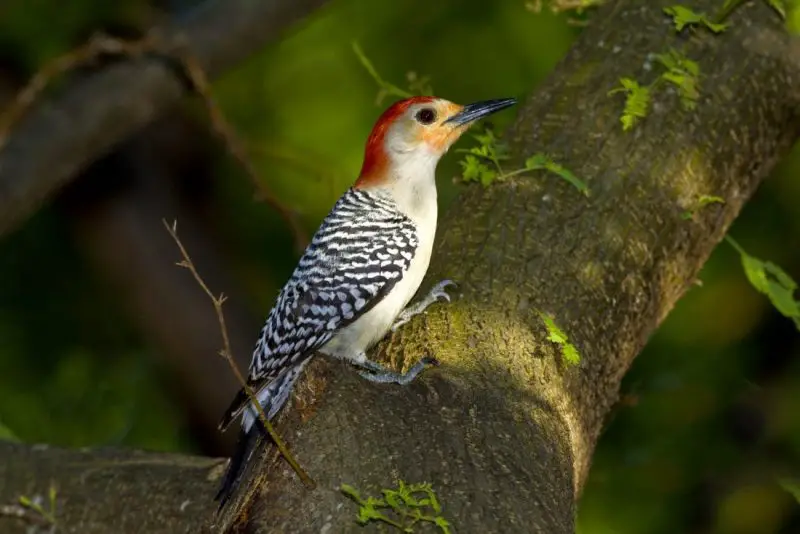
The Red-bellied Woodpecker is a striking bird with black-and-white barred wings, a pale face, and a faint red wash on its lower belly, which is often hard to see. Its most noticeable feature is the bright red crown and nape in males, while females have red only on the nape. It measures around 9.4 inches in length with a wingspan of about 13–16.5 inches and has a strong, straight bill used for foraging and drumming.
This woodpecker is widespread across Maryland’s woodlands, suburban areas, and parks, especially in areas with mature trees. It feeds on insects, nuts, fruits, and even small lizards, often storing food in tree crevices for later use. Red-bellied Woodpeckers are noisy birds, known for their loud, rolling “churr” calls and dramatic vertical clinging behavior.
A fun fact about the Red-bellied Woodpecker is that it has a remarkably long, barbed tongue that wraps around its skull when not in use. This adaptation helps it extract insects from deep crevices. Despite its name, the red on its belly is subtle and often overlooked, while the red on its head is far more visible in the field.
White-breasted Nuthatch (Sitta carolinensis)

The White-breasted Nuthatch is a compact, agile bird with a short tail, long pointed bill, and a distinctive behavior of creeping headfirst down tree trunks. It has a black cap and nape, white face and underparts, and blue-gray upperparts with chestnut-colored flanks. It measures about 5.1–5.5 inches long and has a wingspan of 7.9–10.6 inches.
This species is a common year-round resident in Maryland, favoring mature deciduous forests, especially those with oak, hickory, and beech trees. It feeds on insects, spiders, and seeds, often wedging large items into bark crevices to hammer them open. White-breasted Nuthatches also frequent backyard feeders, where they take sunflower seeds and carry them off to store or crack open elsewhere.
A fun fact about the White-breasted Nuthatch is its unique foraging style—it often walks headfirst down tree trunks, which gives it a different perspective than other birds and helps it find hidden food. It has a nasal, honking call that carries well through the woods, making it one of the more easily heard songbirds in Maryland’s forests.
American Goldfinch (Spinus tristis)
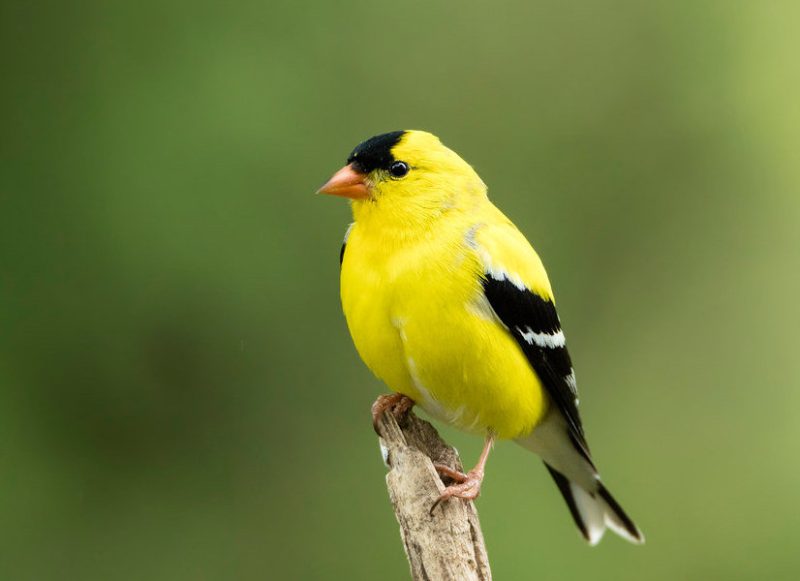
The American Goldfinch is a small, vibrant bird known for its brilliant yellow plumage in males during the breeding season, accented with black wings and a black cap. Females are more subdued in color, with olive-brown tones and no cap. Both sexes have conical orange bills and notched tails, and they measure about 4.3–5.1 inches in length with a wingspan of 7.5–8.7 inches.
This species is common across Maryland in fields, meadows, weedy areas, and suburban gardens. It feeds primarily on seeds from thistles, sunflowers, dandelions, and other composite plants. Unlike many songbirds, goldfinches breed later in the summer when seed supplies are most abundant. They are frequent visitors to feeders stocked with nyjer or sunflower seeds.
A fun fact about the American Goldfinch is that it undergoes a complete molt in late summer, giving it a fresh set of feathers heading into fall. It’s also the state bird of New Jersey, Iowa, and Washington. Goldfinches are acrobatic and often feed while hanging upside down, a behavior that helps them access seeds others can’t reach.
Mourning Dove (Zenaida macroura)

The Mourning Dove is a slender, medium-sized bird with a soft gray-brown body, long pointed tail with white edges, and a small head. It measures about 9–13 inches long with a wingspan of 17–18 inches. Its dark eyes are surrounded by a thin ring of pale blue skin, and its gentle, cooing song gives the bird its name.
This species is abundant throughout Maryland, found in open woodlands, farmland, grasslands, and suburban areas. It primarily feeds on seeds, which it picks up from the ground, and drinks by sucking water without lifting its head. Mourning Doves are fast and agile in flight, with strong wingbeats and a loud whistling sound as they take off.
A fun fact about the Mourning Dove is that it can eat large amounts of seeds in a short time, storing them in its crop before flying off to digest them safely. It can consume up to 20% of its body weight in a single session. These doves often mate for life and are known for their peaceful demeanor and graceful presence in Maryland landscapes.
House Finch (Haemorhous mexicanus)
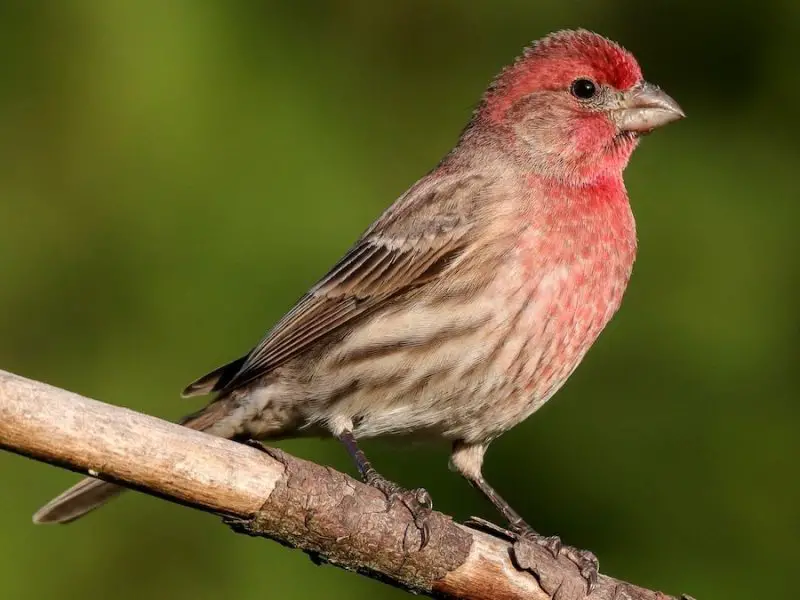
The House Finch is a small, social songbird with a conical bill, slightly notched tail, and streaky brown body. Males are easy to identify by their bright red foreheads, throats, and chests, although the shade can vary from orange to yellow depending on diet. Females lack the red coloring and are uniformly streaked in brown. Both sexes measure about 5–6 inches in length with a wingspan of 8–10 inches.
Originally native to the western United States, House Finches have successfully expanded eastward and are now common year-round residents in Maryland. They thrive in urban, suburban, and rural areas, often nesting on buildings, ledges, and hanging planters. Their diet consists mainly of seeds, fruits, and buds, and they are frequent visitors to backyard feeders offering sunflower or safflower seeds.
A fun fact about the House Finch is that their red coloration comes from pigments in the food they eat, particularly carotenoids found in berries and fruits. The brighter the red, the more attractive the male is to females during mating season. House Finches have a pleasant, warbling song and are often among the first birds to start singing in the morning.
House Sparrow (Passer domesticus)
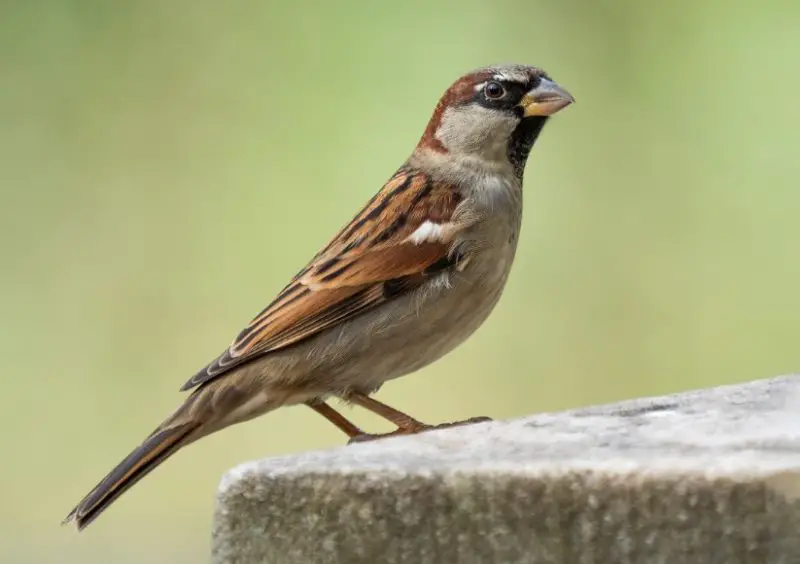
The House Sparrow is a compact, sturdy bird with a short tail and thick bill. Males have gray crowns, black bibs, white cheeks, and chestnut-colored napes, while females and juveniles are duller, with streaked backs and a pale eyebrow line. These birds average about 6.3 inches in length and have a wingspan of approximately 7.5–9.8 inches.
Introduced from Europe in the 19th century, House Sparrows are now widespread and abundant across Maryland. They are found in nearly every human-inhabited environment, from cities and farms to suburban gardens. Their diet includes seeds, crumbs, and insects, and they are aggressive competitors at feeders and nesting sites, often displacing native species.
A fun fact about House Sparrows is that they often dust-bathe in dry soil to clean their feathers and control parasites. Though considered invasive, their adaptability and close association with humans have made them a permanent fixture in the state’s bird population. They frequently nest in crevices, building signs, or vents on houses and buildings.
European Starling (Sturnus vulgaris)
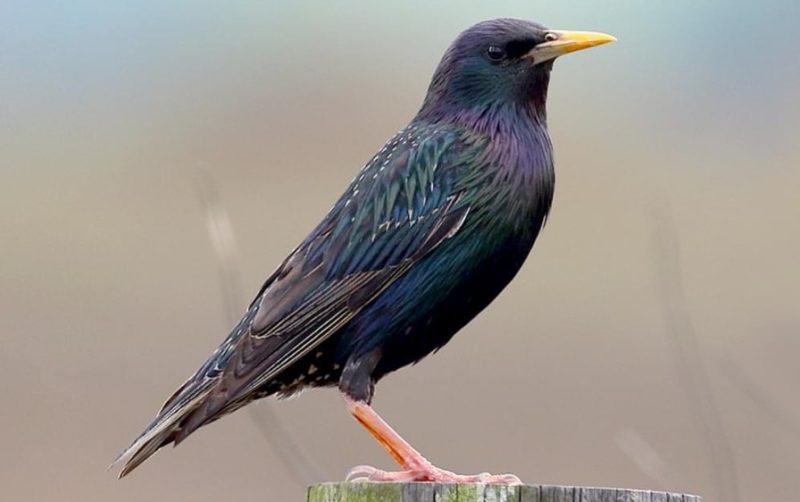
The European Starling is a glossy, medium-sized bird with iridescent black feathers that shimmer green and purple in the right light. In winter, they are speckled with white dots, and in spring, their plumage becomes more sleek and shiny. They have long, pointed bills that are yellow during breeding season and darker at other times. Starlings are about 8–9 inches long with a wingspan of 12–16 inches.
Brought to the U.S. in the 1890s, European Starlings are now among the most widespread and numerous birds in Maryland. They thrive in both rural and urban environments and are often seen in large flocks in open fields, shopping centers, and city parks. They eat insects, fruits, grains, and will aggressively take over nest cavities from native birds.
A fun fact about European Starlings is their remarkable ability to mimic sounds, including other birds and even human noises. They are also famous for their mesmerizing murmurations—large aerial displays of synchronized flight involving hundreds or thousands of birds. Despite their beauty in flight, starlings are considered invasive and can pose challenges for native bird conservation.
Eastern Bluebird (Sialia sialis)
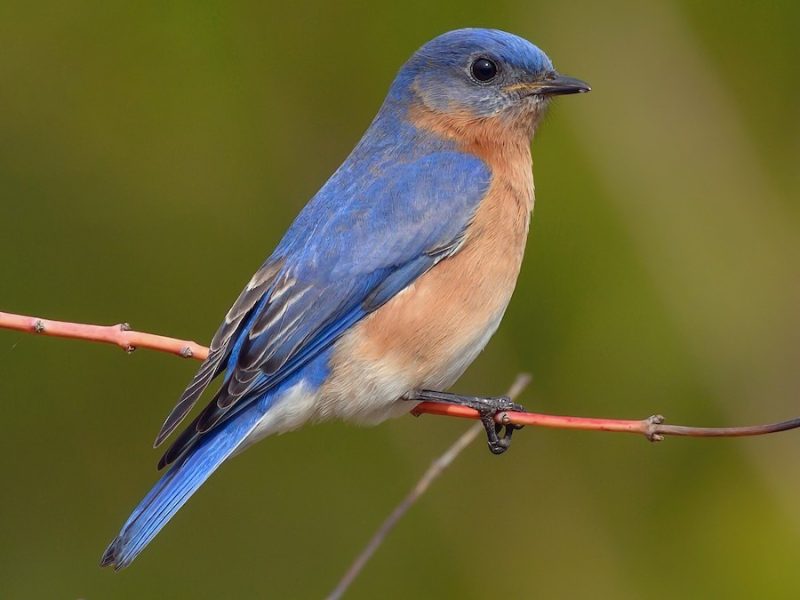
The Eastern Bluebird is a small, charming thrush with vibrant blue upperparts and a warm reddish-orange chest and throat. Females are more subdued, with bluish-gray wings and paler underparts, but still easily recognizable. They measure about 6.3–8.3 inches long with a wingspan of 9.8–12.6 inches and have a graceful, upright posture.
In Maryland, Eastern Bluebirds are found in open fields, orchards, golf courses, and forest edges, especially where nest boxes are provided. They feed primarily on insects during the breeding season, switching to berries and fruits in colder months. Bluebirds are cavity-nesters and readily use man-made birdhouses, which have helped their populations recover from earlier declines.
A fun fact about Eastern Bluebirds is that they are a symbol of happiness and hope in many cultures. Their soft, warbling song and bright coloration make them a favorite among birdwatchers. Thanks to conservation efforts and nest box programs across Maryland, their numbers have steadily increased in recent decades.
Northern Mockingbird (Mimus polyglottos)
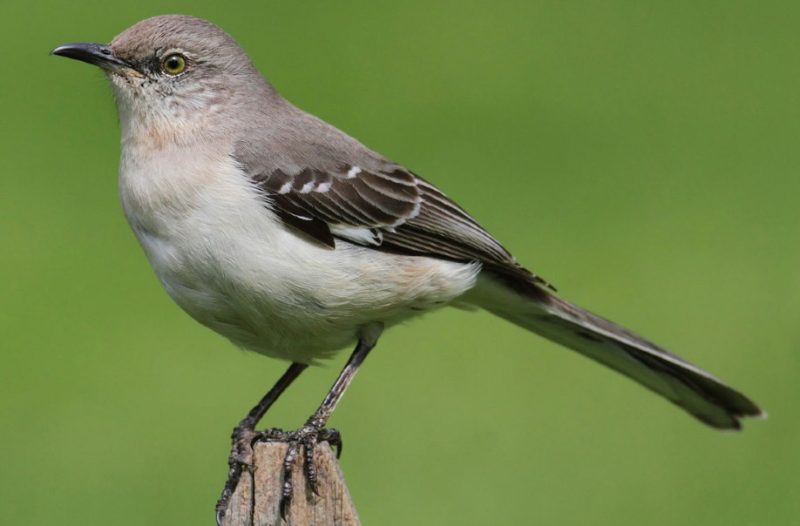
The Northern Mockingbird is a slender, medium-sized bird with gray upperparts, whitish underparts, and bold white wing patches that are visible in flight. Its long tail and sharp, curved beak help with its agile movements. Measuring about 8–10 inches in length with a wingspan of 12–15 inches, it is known more for its vocal abilities than its color.
This bird is a year-round resident across Maryland, often seen in suburban yards, parks, and forest edges. It feeds on insects, fruits, and berries and aggressively defends its territory, sometimes even chasing away cats or hawks. Northern Mockingbirds are famous for their ability to mimic the songs of other birds and even mechanical noises, often repeating each phrase several times.
A fun fact about the Northern Mockingbird is that a single bird may learn up to 200 different songs during its lifetime. Males sing almost constantly during the breeding season, sometimes even at night under full moons or streetlights. Their name, “polyglottos,” literally means “many-tongued,” reflecting their extraordinary vocal range.
Song Sparrow (Melospiza melodia)
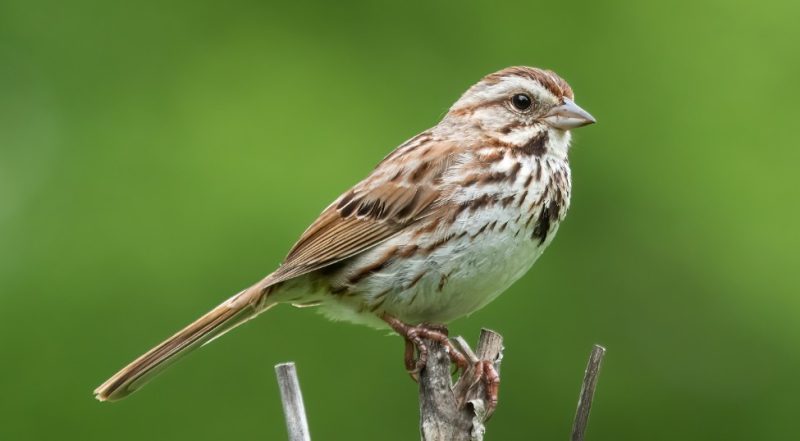
The Song Sparrow is a medium-sized, streaky brown bird with a rounded head, long tail, and a grayish face marked with a brown eye stripe. It has heavy dark streaks on its white underparts that often converge into a central chest spot. Measuring about 4.7–6.7 inches long with a wingspan of 7.1–9.4 inches, its appearance varies slightly across regions, but it’s always subtly patterned and earthy in tone.
This adaptable bird is found year-round in Maryland, occupying marshes, fields, gardens, forest edges, and suburban neighborhoods. It forages mostly on the ground for insects, seeds, and berries, hopping through grasses and leaf litter. Song Sparrows are one of the first birds to sing in the morning, and their varied, sweet melodies make them a welcome presence across the state.
A fun fact about the Song Sparrow is that each male has a unique repertoire of songs, and they learn these by listening to nearby adults during their first summer. Studies show that some even develop local “dialects.” Despite their plain looks, their rich, musical songs are among the most beautiful and distinctive heard in Maryland’s backyards and wetlands.
Chipping Sparrow (Spizella passerina)
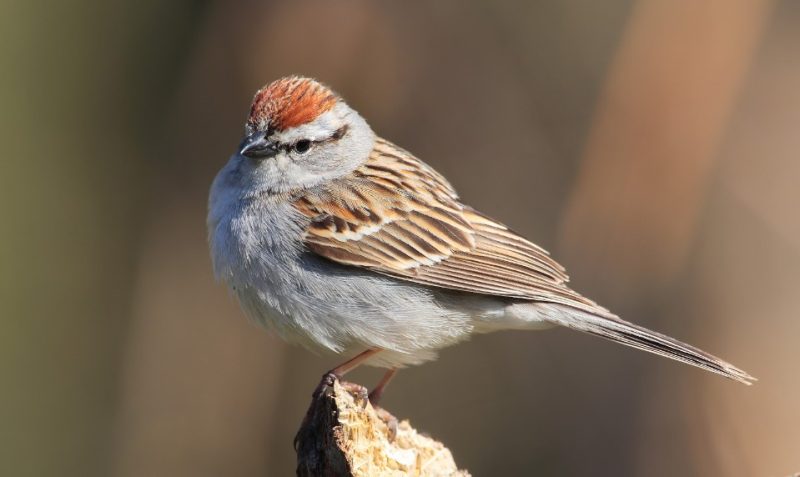
The Chipping Sparrow is a small, slender songbird with a clean, crisp appearance. It has a bright rusty crown, a black eye-line, and a grayish belly and face, giving it a sharp, alert expression. These sparrows measure about 4.7–5.9 inches in length with a wingspan of 8.3 inches and are quick, agile birds often seen in open spaces.
In Maryland, Chipping Sparrows are most common during spring and summer, nesting in open woodlands, parks, and yards with scattered trees. They primarily feed on grass seeds and insects, foraging on the ground or low shrubs. They nest in trees or shrubs, and their dry, mechanical trill is a common sound in warm months.
A fun fact about the Chipping Sparrow is that they undergo a dramatic molt in late summer, during which their bright summer plumage becomes dull and streaky, making them look quite different. This transformation helps them stay camouflaged during fall migration. They often form large flocks in the non-breeding season and can sometimes be seen in mixed groups with other sparrows.
White-throated Sparrow (Zonotrichia albicollis)
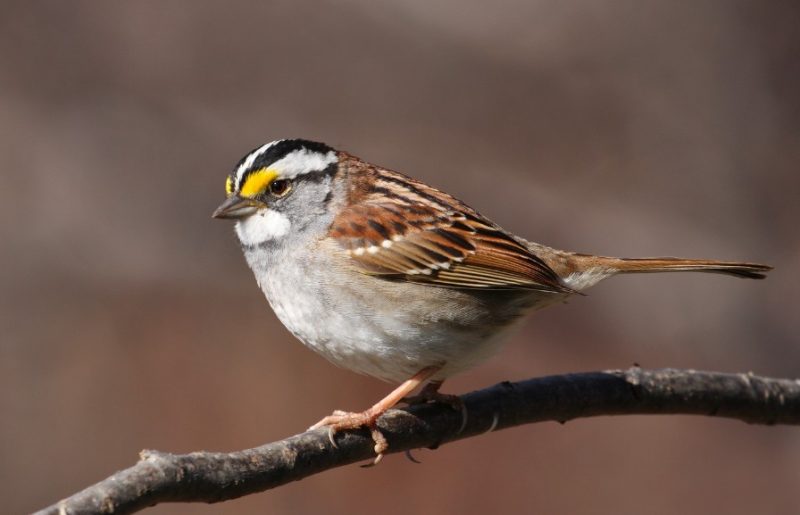
The White-throated Sparrow is a striking and easily recognized bird with a bright white throat patch, bold black-and-white head stripes, and yellow spots between the bill and eyes. It has a gray breast and brown-streaked back, with a plump, rounded body shape. Measuring about 6.3–7.1 inches long, it has a wingspan of around 8.3–9.1 inches.
In Maryland, White-throated Sparrows are common during the winter months, favoring brushy edges, forest understories, and weedy gardens. They scratch at the leaf litter in search of seeds, insects, and berries, often feeding in small flocks. Their plaintive, whistled song—often transcribed as “Old Sam Peabody, Peabody, Peabody”—is a familiar sound during migration and winter.
A fun fact about this species is that it comes in two color forms: white-striped and tan-striped, which differ in behavior. White-striped birds are more aggressive and sing more often, while tan-striped birds are better parents. Interestingly, they tend to mate with the opposite type, helping maintain both color morphs in the population.
Dark-eyed Junco (Junco hyemalis)
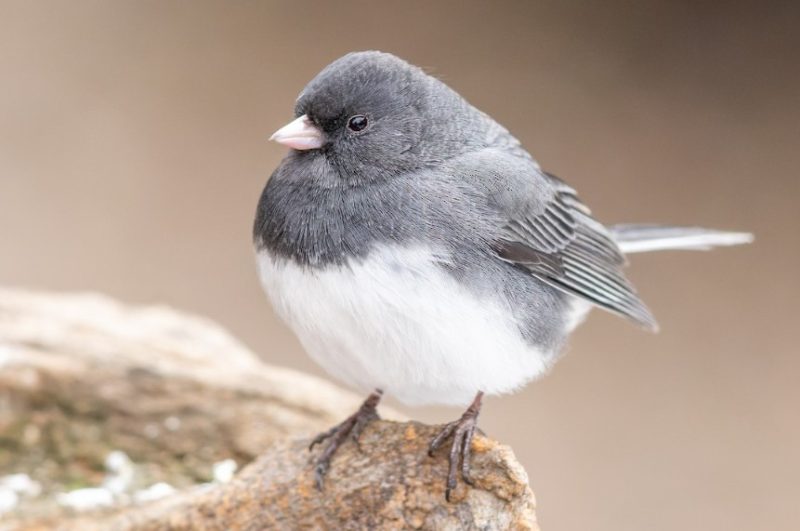
The Dark-eyed Junco is a small, round-bodied sparrow with a slate-gray head and back, white belly, and a pink bill. Its outer tail feathers flash white in flight, creating a distinctive pattern. These birds range from 5.5–6.3 inches in length with a wingspan of about 7.1–9.8 inches and are often seen in flocks during the colder months.
In Maryland, Dark-eyed Juncos are primarily winter visitors, arriving in fall and departing by late spring. They favor open woodlands, forest edges, and suburban yards, where they forage on the ground for seeds and small insects. Juncos are commonly seen beneath feeders, hopping around in search of fallen seed and sometimes forming mixed flocks with sparrows.
A fun fact about juncos is that they are sometimes called “snowbirds” because their arrival often coincides with the first snowfall of the season. Their crisp white and gray plumage blends perfectly with the winter landscape, making them one of the most familiar and welcome signs of the cold months in Maryland.
Red-winged Blackbird (Agelaius phoeniceus)
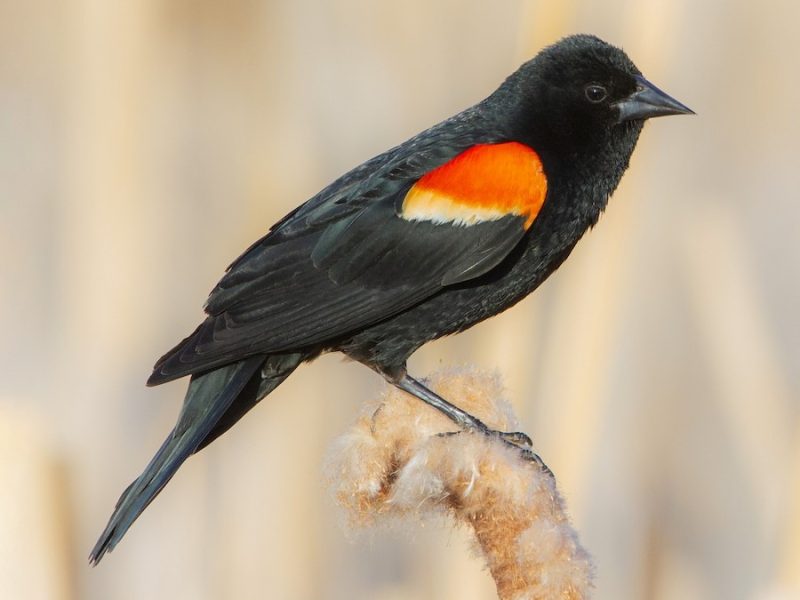
The Red-winged Blackbird is a medium-sized songbird with glossy black plumage in males and bold red-and-yellow shoulder patches, or epaulets. Females look completely different, with heavily streaked brown plumage and a paler face. These birds measure about 6.7–9.1 inches long with a wingspan of 12.2–15.8 inches.
Red-winged Blackbirds are found throughout Maryland, especially near freshwater wetlands, marshes, and grassy fields. Males perch on cattails and tall plants to sing their signature “conk-la-ree” song and defend territory. They feed on seeds and insects and are often seen foraging in flocks during fall and winter.
A fun fact about the Red-winged Blackbird is that males may have multiple mates and defend large territories during the breeding season. Their aggressive behavior extends even to much larger birds or humans, often diving at intruders who come too close to their nests. In winter, they may gather in huge flocks with grackles and starlings, filling the sky with sound and motion.
Common Grackle (Quiscalus quiscula)
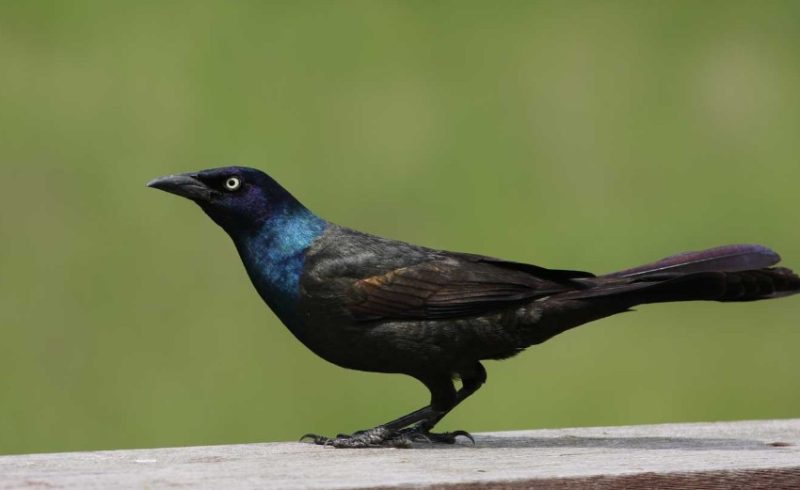
The Common Grackle is a large, lanky blackbird with an iridescent sheen that flashes purple, bronze, or green in the sunlight. It has a long tail, pale yellow eyes, and a strong, slightly curved bill. Measuring about 11–13 inches in length with a wingspan of 14–18 inches, its elongated body and striding gait give it a commanding presence on the ground.
In Maryland, Common Grackles are found year-round, particularly in open woodlands, marshes, farmlands, and suburban areas. They often forage in noisy flocks, searching for insects, grains, seeds, and even small vertebrates. At feeders, they may dominate smaller birds, especially when suet or corn is available. Their call is a harsh, creaky “readle-eak,” often accompanied by puffed-up displays.
A fun fact about the Common Grackle is its tendency to dunk hard food items in water to soften them before eating. Grackles are also known for their shimmering colors, but they are often misunderstood or disliked due to their aggressive flocking behavior. Despite this, they play a significant role in controlling agricultural pests and cleaning up waste.
Brown-headed Cowbird (Molothrus ater)

The Brown-headed Cowbird is a small blackbird with a thick bill and a distinctive, glossy black body in males paired with a rich brown head. Females are plain grayish-brown overall with faint streaks and a pale throat. These birds measure about 6.3–8.7 inches in length and have a wingspan of 12–15 inches, with a short tail and slightly hunched posture.
Brown-headed Cowbirds are found throughout Maryland in fields, pastures, forest edges, and suburban landscapes. They are unique among native birds because they do not build their own nests. Instead, females lay their eggs in the nests of other birds, leaving the foster parents to raise the chicks. Cowbirds eat insects, seeds, and grain, often foraging in open grassy areas.
A fun fact about the Brown-headed Cowbird is that it has been recorded laying eggs in the nests of over 200 different bird species. Some host birds raise cowbird chicks at the expense of their own, while others may reject or bury the intruding egg. This brood parasitism has made the cowbird both a fascinating and controversial figure in bird ecology.
American Crow (Corvus brachyrhynchos)
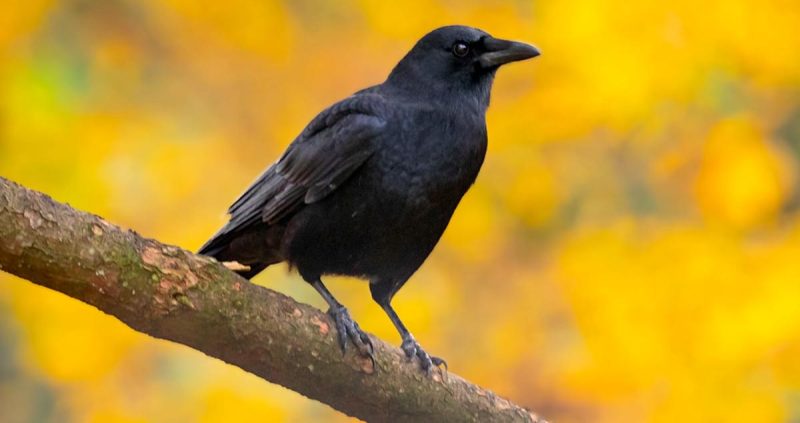
The American Crow is a large, all-black bird with a thick neck, strong bill, and broad wings. It measures about 16–21 inches in length with a wingspan of 33–39 inches. Crows are intelligent and social, often seen in family groups or larger flocks, and their deep “caw-caw” calls are a familiar sound across Maryland.
This species is highly adaptable and occurs statewide in virtually all habitats, including forests, agricultural areas, suburbs, and cities. American Crows are omnivores and opportunistic feeders, consuming everything from insects and grains to carrion and human garbage. They are known for using tools, recognizing human faces, and even participating in funeral-like gatherings around dead crows.
A fun fact about American Crows is their extraordinary memory and problem-solving ability. Studies have shown they can remember and warn others about individual humans who pose threats. In Maryland, they often roost communally in winter, forming noisy groups that can number in the thousands, especially near urban areas.
Fish Crow (Corvus ossifragus)
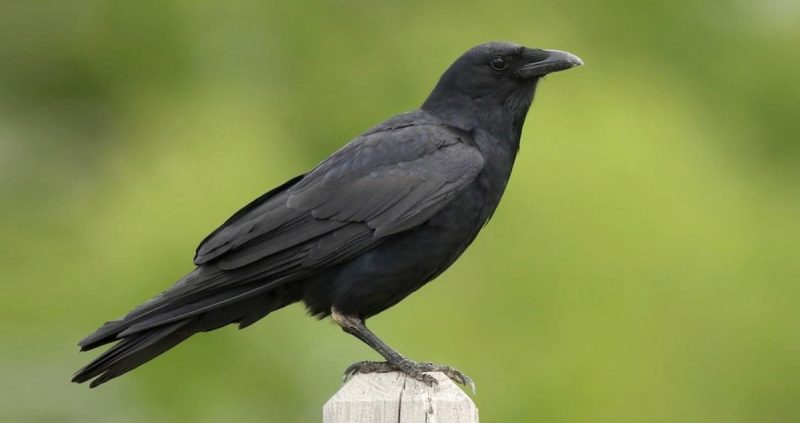
The Fish Crow is a close relative of the American Crow but slightly smaller, with more slender features and a silkier plumage. It is nearly identical in appearance, measuring about 14–17 inches in length with a wingspan of 28–33 inches, but can be distinguished by its higher-pitched, nasal “uh-uh” call, which sounds almost like a sneeze.
Fish Crows are found along coastal regions, rivers, marshes, and urban areas throughout much of Maryland, especially near the Chesapeake Bay and tidal waterways. Like other crows, they are omnivorous and highly adaptable, feeding on fish, carrion, insects, eggs, fruit, and human food scraps. They are often seen foraging in groups or flying low over water.
A fun fact about Fish Crows is that their range has expanded significantly inland over recent decades, aided by urbanization and food availability. Because they look so similar to American Crows, the easiest way to identify them is by voice. Birders in Maryland often rely on sound alone to distinguish these clever and elusive birds.
Baltimore Oriole (Icterus galbula)
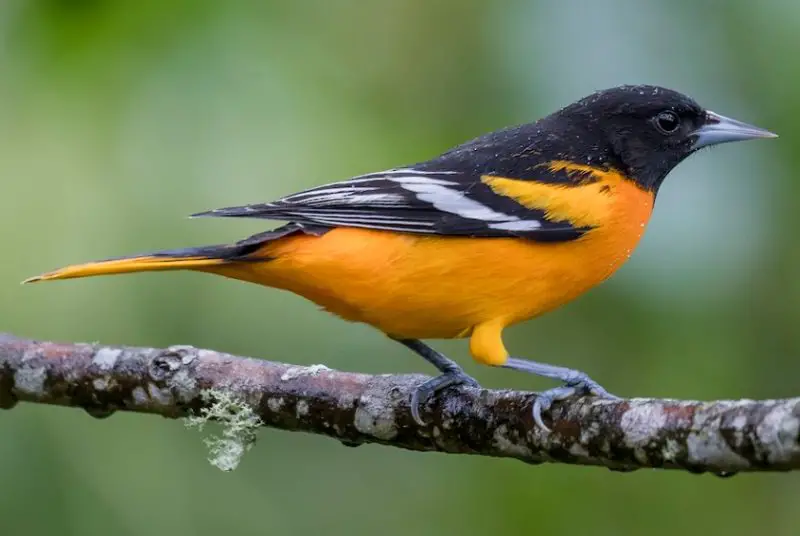
The Baltimore Oriole is one of Maryland’s most iconic birds, celebrated for its vivid orange and black plumage in males and warm yellow-orange tones in females. Males have a black head, back, and wings with bright orange underparts, while females are paler with two white wing bars. They measure about 6.7–7.5 inches in length with a wingspan of 9–12 inches.
In Maryland, Baltimore Orioles are most often seen in spring and summer, arriving in late April to breed and departing by mid-fall. They prefer open woodlands, forest edges, and residential areas with tall deciduous trees. Their diet includes insects, fruit, and nectar, and they are easily attracted to feeders offering orange halves or grape jelly.
A fun fact about the Baltimore Oriole is that it’s the state bird of Maryland, named after the orange-and-black colors of Lord Baltimore’s family crest. Their hanging, pouch-like nests are woven from plant fibers and suspended from tree branches, showcasing their exceptional craftsmanship. Their flutelike, melodic songs add a splash of beauty and sound to Maryland’s late spring and summer landscapes.
Gray Catbird (Dumetella carolinensis)
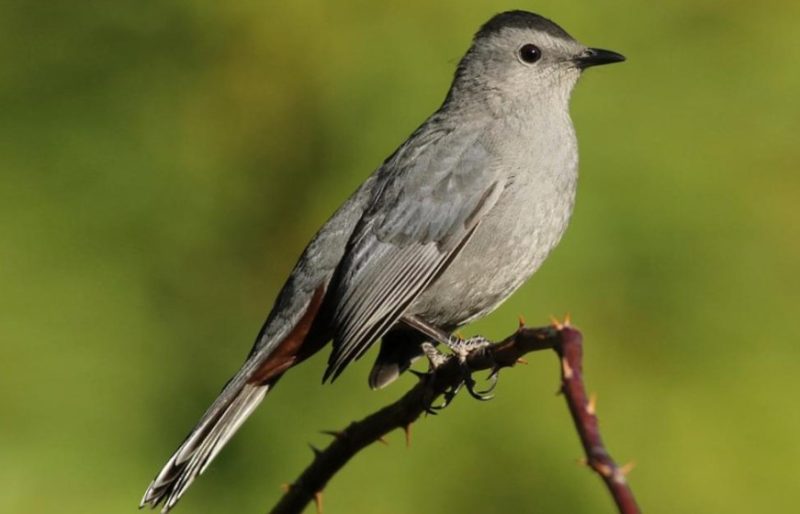
The Gray Catbird is a sleek, medium-sized songbird with smooth slate-gray plumage, a black cap, and a distinctive rusty patch beneath its tail. It measures about 8.3–9.4 inches in length with a wingspan of 8.7–11.8 inches. Its slender build and long tail give it an elegant profile as it moves through dense shrubs and thickets.
This species is a common summer resident in Maryland, especially in brushy woodlands, suburban gardens, and hedgerows. It feeds on insects, berries, and fruits, often seen foraging in low vegetation or on the ground. The Gray Catbird gets its name from its cat-like “mew” call, though it also mimics the songs of many other birds and sounds in its environment.
A fun fact about the Gray Catbird is that it can learn and remember over 100 different sounds. Unlike mockingbirds, which repeat phrases, the catbird tends to string together a continuous flow of unique sounds in a long, complex song. Its secretive nature and preference for dense cover often make it easier to hear than to see.
Eastern Towhee (Pipilo erythrophthalmus)
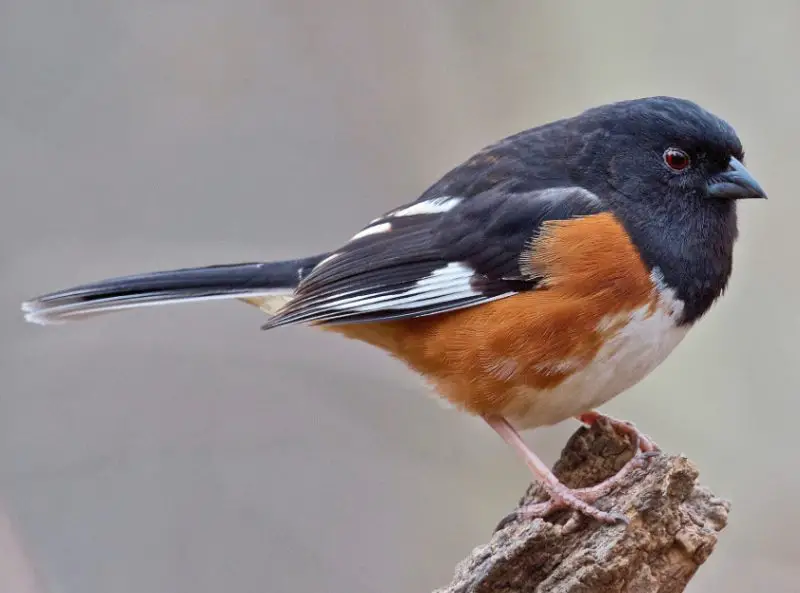
The Eastern Towhee is a striking ground-dwelling songbird with bold coloration. Males are black above with rusty flanks and a white belly, while females are similar but have rich brown instead of black. They are stocky and have bright red eyes, a long tail with white edges, and a thick, sparrow-like bill. They measure about 6.8–9.1 inches long with a wingspan of 7.9–11 inches.
In Maryland, Eastern Towhees are found in shrubby forests, thickets, and overgrown fields, particularly in areas with dense underbrush. They forage by scratching at leaf litter with both feet to uncover insects, seeds, and berries. Their call is a sharp “chewink” or “tow-hee,” and their song is a sweet “drink-your-tea” that’s often heard in spring.
A fun fact about Eastern Towhees is that males often sing from exposed perches while the rest of their time is spent hidden in thick cover. Though they are ground foragers, they nest low in bushes or directly on the ground. Their secretive habits make them less visible, but their distinctive call often reveals their presence.
Ruby-throated Hummingbird (Archilochus colubris)

The Ruby-throated Hummingbird is the only breeding hummingbird species in Maryland, known for its dazzling green back and iridescent ruby-red throat in males. Females lack the red throat and are paler overall, with white underparts and green flanks. These tiny birds measure only 2.8–3.5 inches long with a wingspan of about 3.1–4.3 inches.
They are summer visitors in Maryland, favoring gardens, woodland edges, and meadows rich in flowering plants. Ruby-throated Hummingbirds feed primarily on nectar, but also consume small insects and spiders for protein. They are agile flyers, capable of hovering and flying backward, with wings that beat up to 80 times per second.
A fun fact about the Ruby-throated Hummingbird is that it can migrate more than 1,000 miles, including a non-stop flight over the Gulf of Mexico. Despite their tiny size, these birds are fiercely territorial around feeding areas. Many Maryland residents attract them by hanging red-colored nectar feeders during the spring and summer.
Barn Swallow (Hirundo rustica)
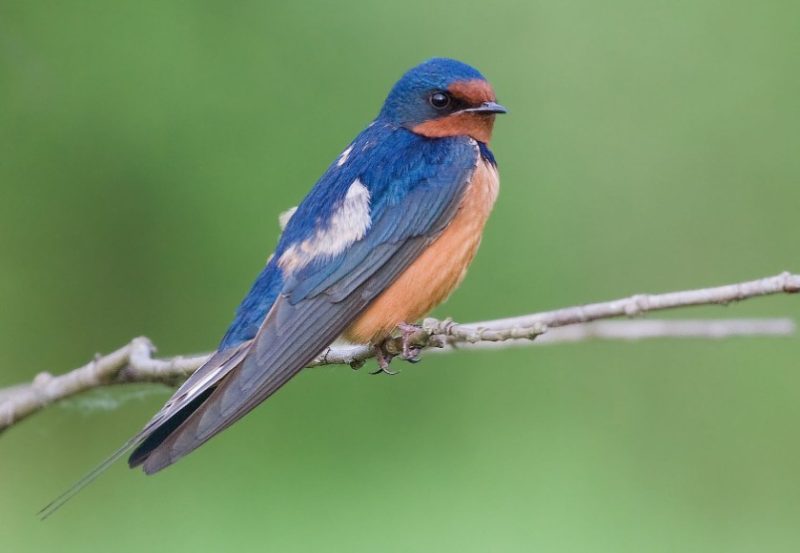
The Barn Swallow is a graceful, slender bird with long, pointed wings and a deeply forked tail that trails behind in flight. It has a shiny blue back, rufous throat and forehead, and a buff-colored belly. This agile flyer measures about 5.9–7.5 inches long with a wingspan of 11.4–12.6 inches, and is often seen swooping over open areas.
In Maryland, Barn Swallows are summer breeders that nest in open landscapes such as farmland, meadows, and towns. True to their name, they often build cup-shaped mud nests on beams inside barns, under bridges, or on porches. They catch flying insects in mid-air and rarely land except to perch or feed their young.
A fun fact about Barn Swallows is that they have been closely associated with humans for centuries, nesting in man-made structures across continents. Their acrobatic flight and cheerful twittering calls make them a favorite sight during warm months in Maryland. By eating hundreds of insects a day, they also help control pest populations.
Tree Swallow (Tachycineta bicolor)
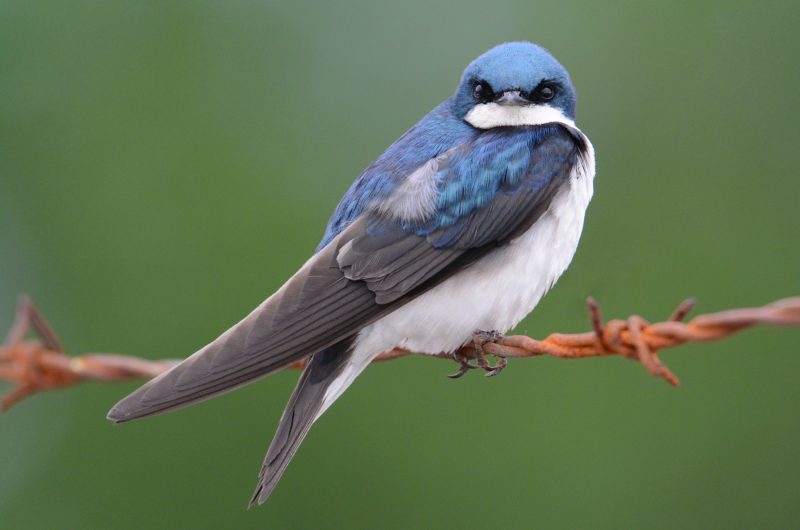
The Tree Swallow is a sleek, small songbird with shimmering blue-green upperparts, a white underside, and long pointed wings. Both sexes look similar, although females may have duller plumage. They measure about 4.7–5.9 inches in length with a wingspan of 11.8–13.8 inches and are known for their quick, darting flight.
These swallows are common in Maryland during the breeding season, favoring wetlands, open fields, and areas near water where flying insects are abundant. Tree Swallows nest in natural tree cavities or nest boxes and form loose colonies. Their diet consists almost entirely of flying insects, and they can often be seen gliding over ponds and marshes.
A fun fact about Tree Swallows is that they begin their northward migration earlier than most other songbirds, sometimes arriving in Maryland while snow is still on the ground. When insect prey is scarce, they are among the few insectivores that can survive temporarily on berries, giving them an advantage during cold snaps.
Cedar Waxwing (Bombycilla cedrorum)
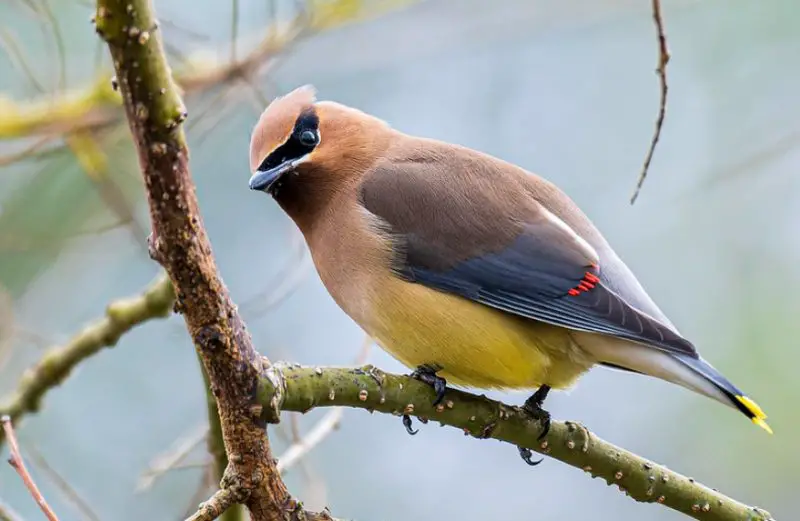
The Cedar Waxwing is a sleek, elegant songbird with silky plumage, a pale brown head and chest fading to gray wings and a yellow-tipped tail. One of its most distinctive features is the black mask outlined in white across its face, along with waxy red tips on some wing feathers. These medium-sized birds measure about 6–7 inches long with a wingspan of 8.7–11.8 inches.
In Maryland, Cedar Waxwings are seen year-round but are most abundant during fall and winter when they form flocks to search for berries. They are often found in forest edges, orchards, parks, and residential areas with fruiting trees and shrubs. Their diet is primarily made up of fruit, though they also catch insects in flight during the warmer months.
A fun fact about Cedar Waxwings is that they sometimes become intoxicated from eating fermented berries. These birds are highly social and often pass food from one individual to another in courtship or group feeding behavior. Their soft, high-pitched “see” calls and smooth, graceful flight make them a quiet but captivating presence in Maryland’s treetops.
Northern Flicker (Colaptes auratus)
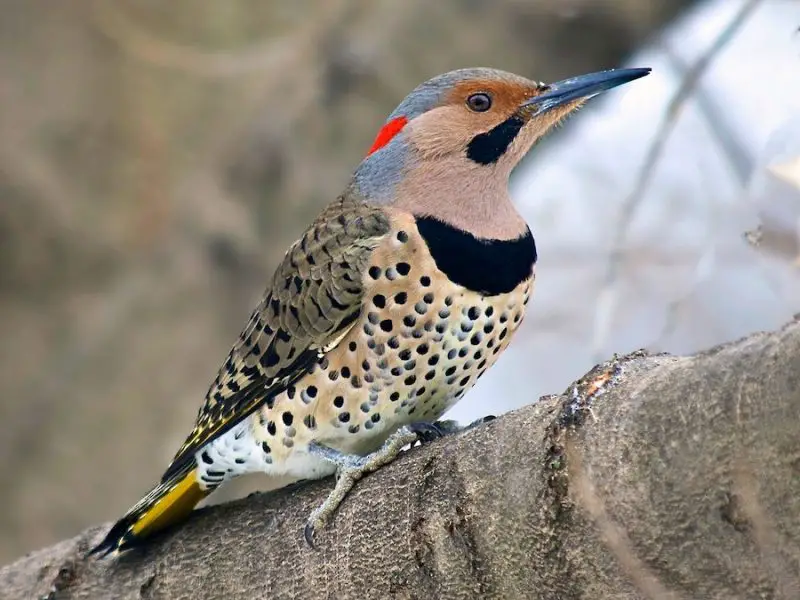
The Northern Flicker is a large, ground-feeding woodpecker with striking plumage. It has a brown back with black barring, a spotted belly, and a black crescent on the chest. In Maryland, the “Yellow-shafted” form is common, featuring bright yellow underwings and a red patch on the nape. These birds measure 11–12.2 inches in length with a wingspan of 16.5–20 inches.
Unlike most woodpeckers, Northern Flickers often forage on the ground, probing the soil for ants and beetles. They also feed on fruits and seeds and will visit suet feeders. In Maryland, they nest in tree cavities in wooded areas, parks, and suburban yards. Their loud “wick-a-wick-a-wick” call and rhythmic drumming are common sounds in spring and summer.
A fun fact about Northern Flickers is that they use their long, barbed tongues to lap up ants, which can make up over half their diet. They also perform a unique courtship display called “fencing,” where two birds bob and face off while calling and flaring their wings and tails. Their spotted pattern and flickering flight make them easy to spot across the state.
Carolina Wren (Thryothorus ludovicianus)
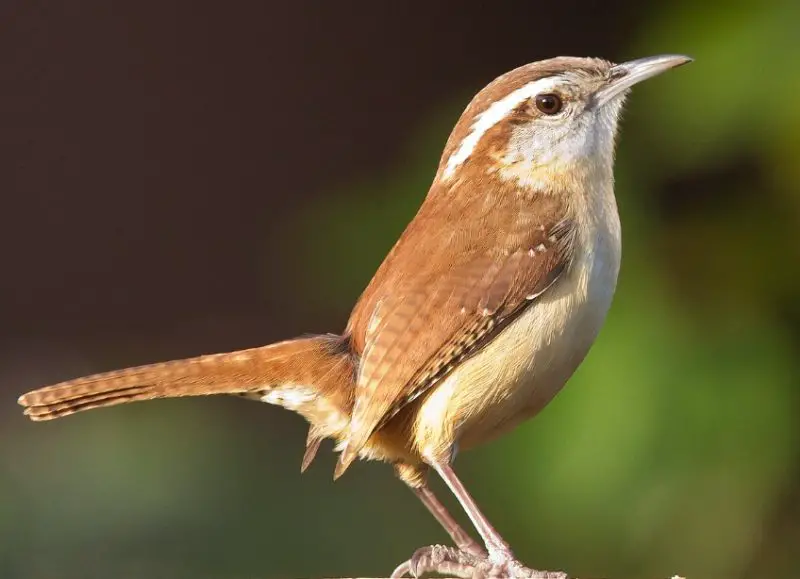
The Carolina Wren is a small but energetic bird with a rich reddish-brown back, warm buffy underparts, and a bold white eyebrow stripe. It has a slightly curved bill and a rounded body with a cocked tail. Measuring about 4.7–5.5 inches in length with a wingspan of 11 inches, it’s larger and louder than other wrens.
This bird is a year-round resident in Maryland and thrives in wooded areas, thickets, overgrown gardens, and suburban backyards. It eats insects and spiders primarily, but also seeds and berries, and readily visits suet feeders. Despite its small size, the Carolina Wren has a loud, musical voice and sings a series of clear, whistled notes that often sound like “teakettle-teakettle-teakettle.”
A fun fact about Carolina Wrens is that they often build nests in unconventional spots such as flower pots, mailboxes, and hanging planters. They are curious and bold, exploring every corner of their territory. Even in cold winters, they remain active and vocal, providing cheerful songs through the quieter months in Maryland.
Blue-gray Gnatcatcher (Polioptila caerulea)
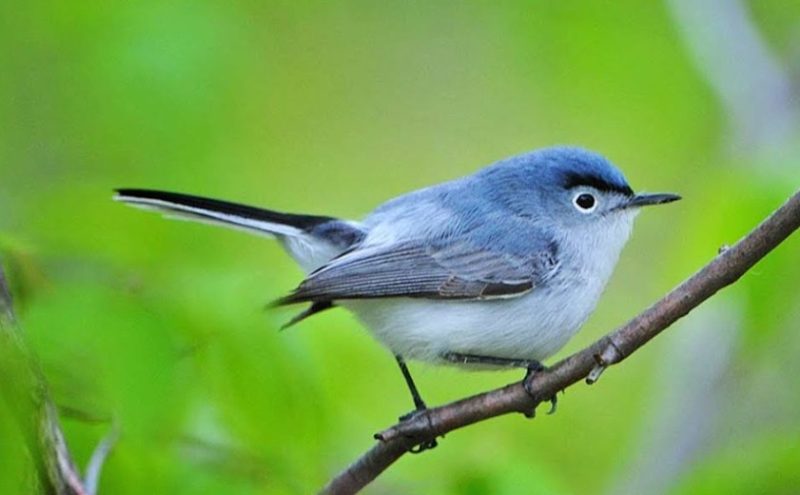
The Blue-gray Gnatcatcher is a tiny, active songbird with soft blue-gray plumage, a white eye ring, and long black tail with white edges. It measures just 3.9–5.1 inches in length and has a wingspan of 6.3 inches. It resembles a miniature mockingbird in both shape and tail movement, constantly flicking its tail while foraging.
This species is a summer breeder in Maryland, especially in deciduous forests, woodlands, and shrubby areas near water. It feeds on tiny insects and spiders, often gleaned from leaves or caught in midair. Its high-pitched, buzzy calls and nasal songs are distinctive once learned and help birders detect its presence high in the canopy.
A fun fact about the Blue-gray Gnatcatcher is that it builds a compact, cup-shaped nest made from spider silk, lichen, and bark strips, which blends perfectly into tree branches. They are among the first neotropical migrants to return in spring and are known for their ceaseless activity as they flit through foliage in search of prey.
Great Crested Flycatcher (Myiarchus crinitus)
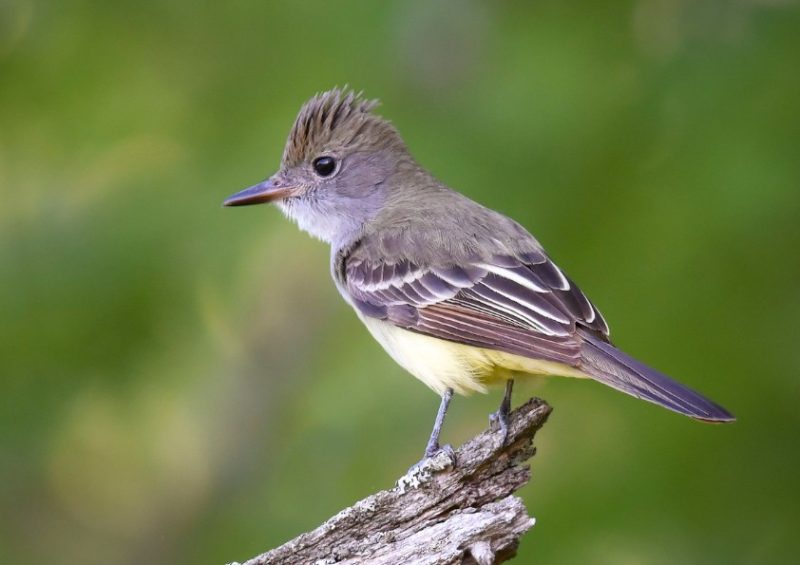
The Great Crested Flycatcher is a large and bold member of the flycatcher family. It has a gray head and breast, bright yellow belly, reddish-brown wings and tail, and a slight crest. These birds measure around 6.7–8.3 inches in length with a wingspan of 13 inches. Though often heard before seen, they have a commanding presence in the treetops.
In Maryland, Great Crested Flycatchers are summer breeders found in mature deciduous forests, forest edges, and large wooded parks. They forage by sallying from high perches to catch flying insects or by gleaning prey from leaves. They also eat fruits and berries, especially later in the season, and nest in natural cavities or birdhouses.
A fun fact about the Great Crested Flycatcher is that it often adds shed snake skins to its nest, possibly to deter predators. Its loud, rising “whee-eep” call is a familiar sound in summer woodlands. These birds stay high in the canopy, so their bright colors are often glimpsed as flashes of yellow and cinnamon among the leaves.
Eastern Phoebe (Sayornis phoebe)
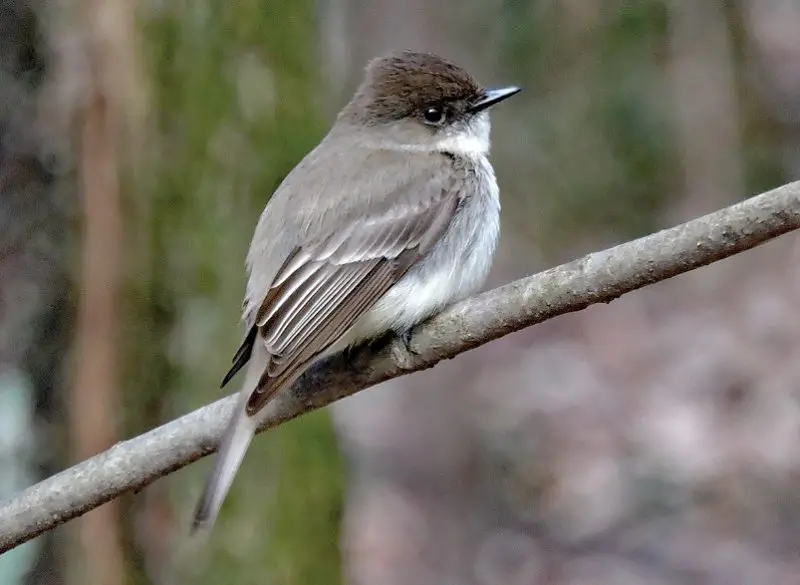
The Eastern Phoebe is a small flycatcher with plain grayish-brown upperparts, a whitish belly, and a slight crest on its head. It lacks bold markings but is easily recognized by its frequent tail-wagging behavior. This bird measures about 5.5–6.7 inches long with a wingspan of 10.2–11 inches and has a slender bill used to snatch flying insects.
In Maryland, the Eastern Phoebe is a common migrant and summer breeder found near streams, wooded edges, and human structures. It feeds primarily on insects, which it catches in short flights from a perch. These birds often build their nests under bridges, porch eaves, and in sheds, using mud and moss to form a cup-shaped structure.
A fun fact about the Eastern Phoebe is that it was the first bird species in North America to be banded for scientific study, by John James Audubon in the early 1800s. Its raspy “fee-bee” call, from which it gets its name, is a sure sign of spring in Maryland. Unlike many flycatchers, it often returns to the same nesting site year after year.
Red-tailed Hawk (Buteo jamaicensis)
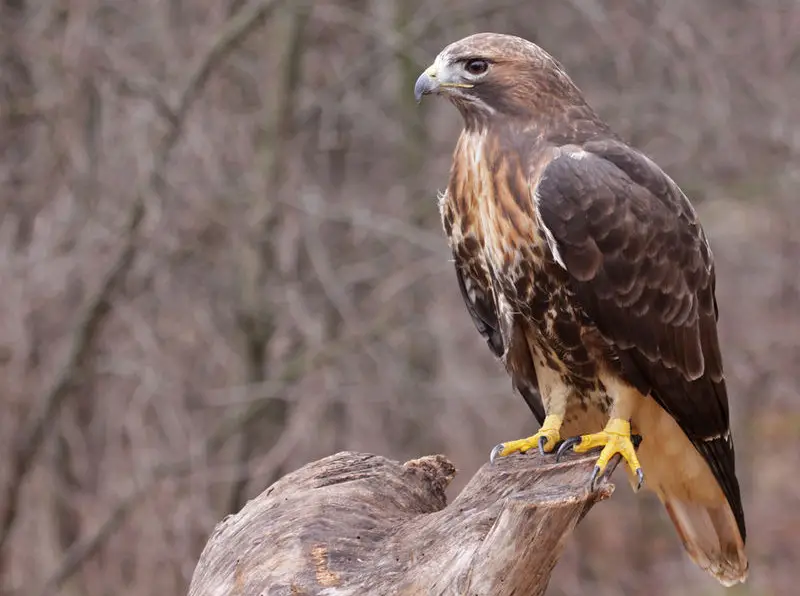
The Red-tailed Hawk is a large, powerful raptor with broad wings and a short, wide tail. Adults have a rich rufous-red tail, a pale belly with a dark belly band, and dark-streaked brown upperparts. It measures about 18–26 inches long with a wingspan of 43–56 inches, making it one of the most widespread hawks in North America.
This species is found throughout Maryland in woodlands, open fields, and along highways. It often perches on utility poles or glides over open areas in search of prey such as small mammals, birds, and reptiles. Red-tailed Hawks are known for their piercing, descending scream that is often used in movies to represent any bird of prey.
A fun fact about the Red-tailed Hawk is that it mates for life and performs dramatic aerial courtship displays, including spiraling dives and talon-locking. Young hawks have brown tails with narrow dark bands and don’t acquire the signature red tail until their second year. In winter, they are more visible as they soar or perch in exposed spots.
Cooper’s Hawk (Accipiter cooperii)
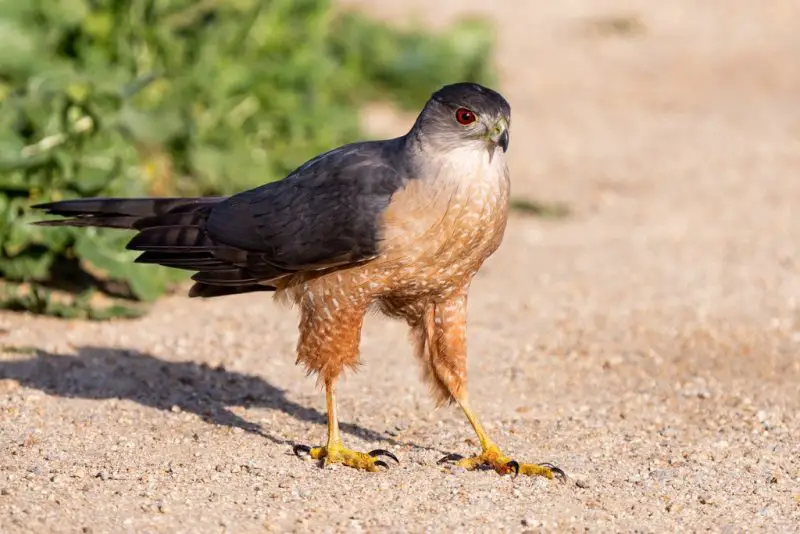
The Cooper’s Hawk is a medium-sized raptor with short, rounded wings and a long, banded tail. Adults have slate-gray backs, reddish-barred chests, and fierce red eyes. Juveniles are brown above with streaked underparts and yellow eyes. These hawks measure about 14–20 inches in length with a wingspan of 24–35 inches.
Cooper’s Hawks are year-round residents in Maryland and are often found in wooded areas, suburban neighborhoods, and near bird feeders, where they prey on small birds. They are agile flyers capable of weaving through trees at high speed to catch prey by surprise. Their diet includes songbirds, doves, and squirrels.
A fun fact about Cooper’s Hawks is that they are sometimes mistaken for the similar Sharp-shinned Hawk, but they are stockier and have a more rounded tail. These hawks use surprise and speed rather than soaring to hunt, and their hunting success depends heavily on stealth. They play an important role in controlling populations of other birds.
Turkey Vulture (Cathartes aura)

The Turkey Vulture is a large, dark bird with broad wings, a long tail, and a distinctive red, featherless head. In flight, it soars with its wings held in a shallow V-shape and rocks side to side. It measures 25–32 inches long with a wingspan of 63–72 inches, making it one of the largest birds in Maryland.
Turkey Vultures are common throughout the state, especially in rural and forested areas. They feed exclusively on carrion and use their keen sense of smell—unusual among birds—to locate decaying animals. These vultures often roost in large groups and are frequently seen soaring overhead with minimal wing-flapping.
A fun fact about Turkey Vultures is that they can detect the scent of dead animals from more than a mile away. They also play a critical role in the ecosystem by cleaning up dead wildlife and preventing the spread of disease. Despite their grim diet, they are gentle birds and do not kill live prey.
Black Vulture (Coragyps atratus)
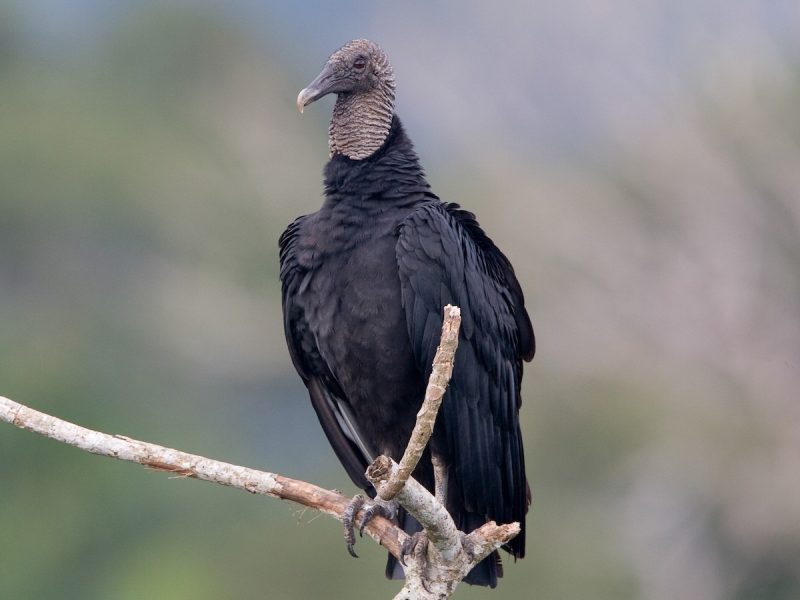
The Black Vulture is slightly smaller than the Turkey Vulture and has black plumage, a short tail, and a gray, wrinkled head. In flight, it is easily distinguished by its white wingtips, broad wings, and rapid flapping. These birds measure about 22–27 inches in length with a wingspan of 54–60 inches.
In Maryland, Black Vultures are found statewide, especially in open country, near roads, and around landfills or carcasses. They feed on carrion but also scavenge human refuse and occasionally prey on weak animals. Unlike Turkey Vultures, they rely more on sight than smell to find food and often follow Turkey Vultures to carcasses.
A fun fact about Black Vultures is their highly social nature—they often forage, roost, and even raise young in groups. These vultures are known to be more aggressive at feeding sites, chasing off other scavengers. Their strong family bonds include cooperative parenting, with multiple birds helping to feed chicks in a shared nest.
Belted Kingfisher (Megaceryle alcyon)

The Belted Kingfisher is a stocky, crested bird with a large head, thick bill, and slate-blue plumage above with white underparts. Males have a single blue chest band, while females—unusually—are more colorful with an additional rusty band across the belly. It measures about 11–14 inches long with a wingspan of 19–23 inches.
This bird is found near rivers, lakes, and coastlines throughout Maryland, often perched on branches over water. It hunts by diving headfirst to catch small fish, crayfish, and aquatic insects. Its rattling, mechanical call often announces its presence before it’s seen speeding low across the water.
A fun fact about the Belted Kingfisher is that it nests in burrows excavated into sandy banks, sometimes as deep as eight feet. Despite its fishing habits, it occasionally swallows prey headfirst to prevent fins from catching in its throat. It is one of the few bird species where the female is more vividly marked than the male.
Canada Goose (Branta canadensis)
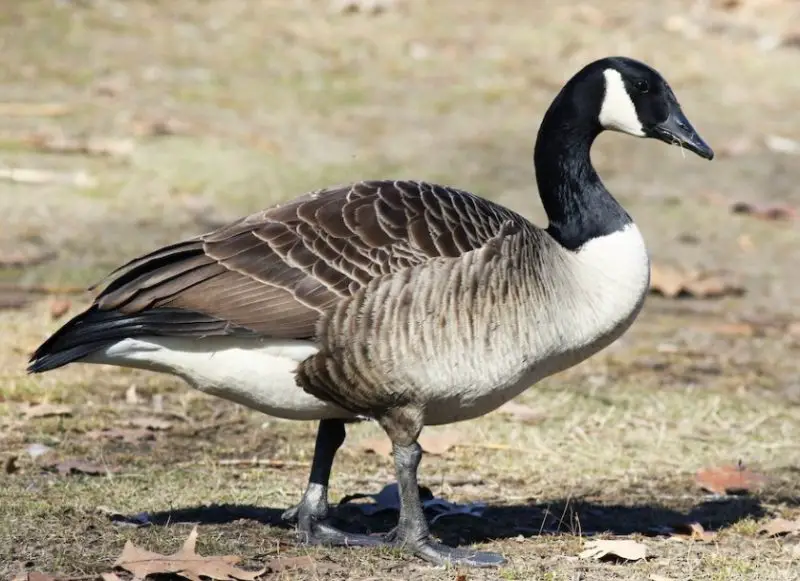
The Canada Goose is a large waterfowl species with a long black neck and head, white chinstrap, brown back, and pale chest. It measures 30–43 inches long with an impressive wingspan of 50–67 inches. Its loud, honking call is a familiar sound during migration or when large flocks take flight.
Canada Geese are common year-round in Maryland, especially in wetlands, lakes, golf courses, and farm fields. Some populations migrate, but many are now resident and breed locally. These geese graze on grasses, grains, and aquatic plants and often feed in flocks. Their V-shaped formations in flight are a classic migration sight in fall and spring.
A fun fact about Canada Geese is that they are fiercely protective parents, often hissing or charging at intruders near their nests. They mate for life and return to the same nesting sites each year. Though sometimes viewed as pests due to their numbers, their strong family bonds and impressive migrations are admired by many.
FAQs about Common Birds in Maryland
What are some of the most common birds found in Maryland?
Maryland hosts a diverse range of bird species, but some of the most common include the Northern Cardinal, American Robin, Blue Jay, Carolina Chickadee, and Tufted Titmouse. These birds are frequently seen in backyards, parks, and forests throughout the state.
When is the best time to observe common birds in Maryland?
The best time to observe common birds in Maryland is during the spring and summer breeding seasons when birds are most active and vocal. Migratory species can also be seen during spring and fall migrations. Winter months offer a chance to spot hardy resident birds and some winter visitors.
How can I attract common birds to my backyard in Maryland?
To attract common birds, provide a variety of feeders with seeds like sunflower and safflower, fresh water sources, and native plants that offer food and shelter. Birdhouses and nesting boxes can also encourage species like Eastern Bluebirds and Tree Swallows to nest.
What types of habitats do common Maryland birds prefer?
Common Maryland birds inhabit a wide range of habitats including woodlands, wetlands, suburban neighborhoods, open fields, and gardens. Each species has its preferred environment, such as water bodies for Belted Kingfishers or dense shrubs for Carolina Wrens.
Are there any endangered or threatened common birds in Maryland?
Most common birds in Maryland have stable populations, but some species face habitat loss and environmental threats. It’s important to support conservation efforts to protect habitats and ensure these birds continue to thrive in the state.

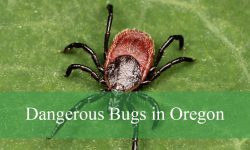
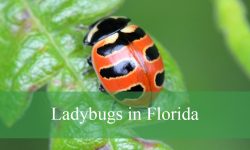

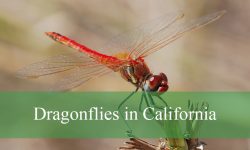


Why was the Pileated Woodpecker left out of the article? They are often seen and always heard in my woods and yard.
Thanks for your updating